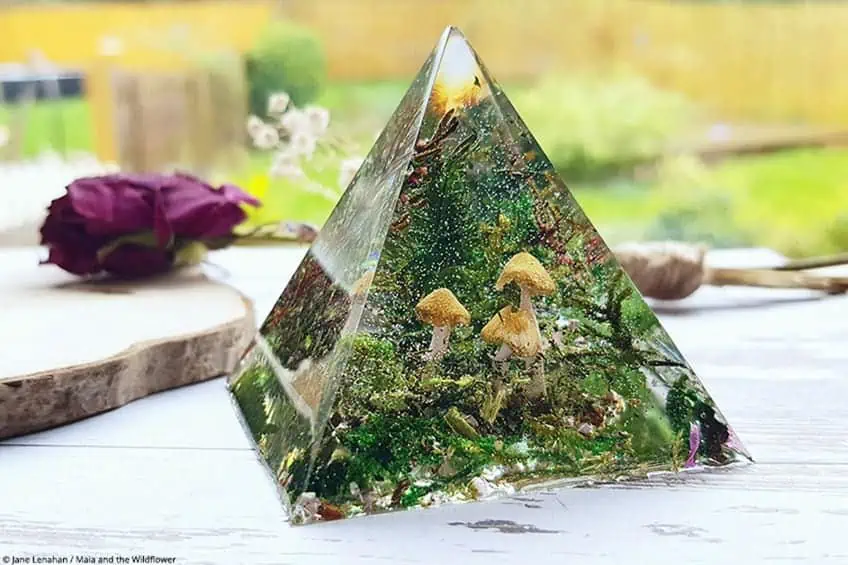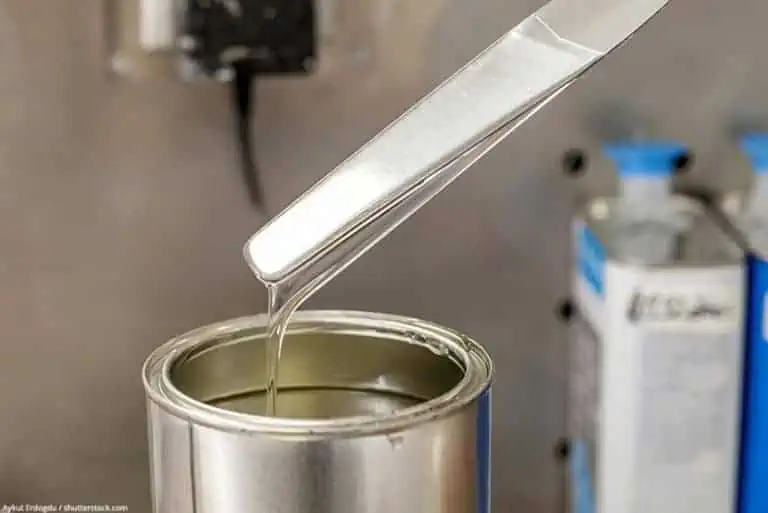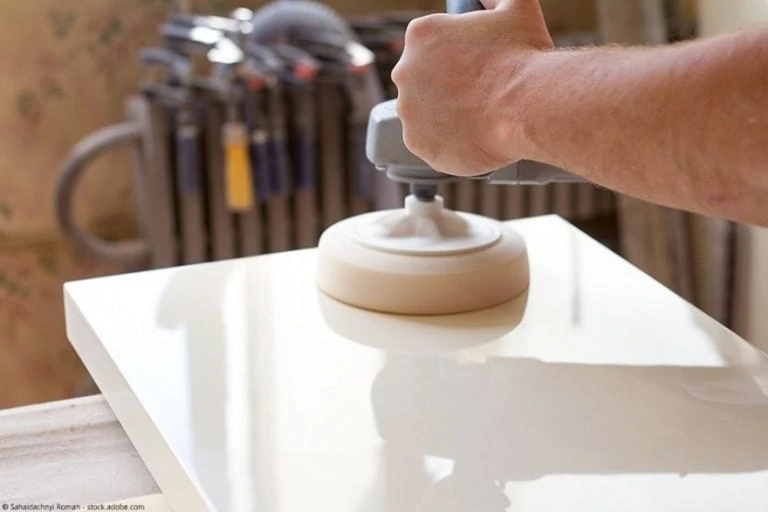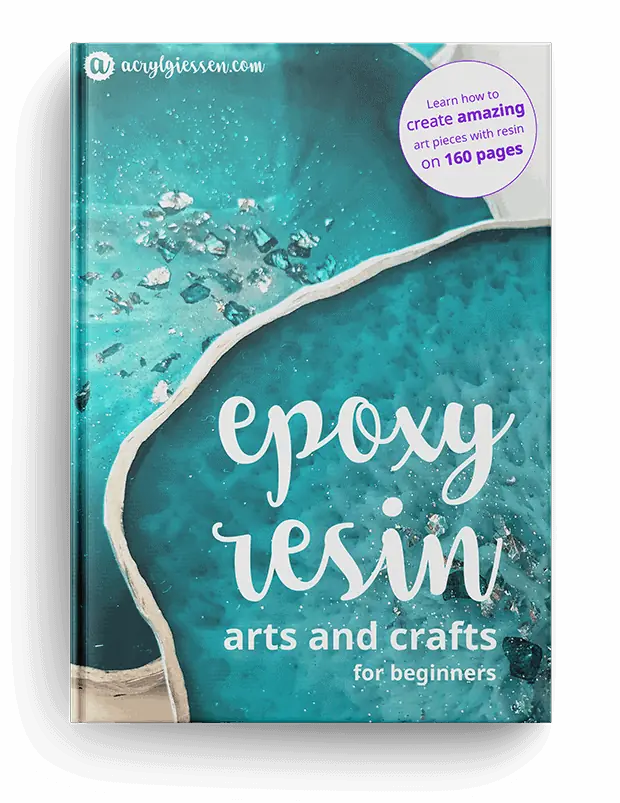Best Deep Pour Epoxy – Make Successful Thick Pours
This post may contain affiliate links. We may earn a small commission from purchases made through them, at no additional cost to you.
Epoxy resin is great; you can use it to create pretty much anything you set your mind to, from jewelry, tabletops, masks, floor coatings, food containers, coasters, and even protective coatings for tabletops! Not all types of resin can be used for every application though, as certain resins are only graded for surface applications like coating puzzles or countertops. Others can be used to fill molds and create castings. This type of resin is known as deep pour resin and has been specifically designed to be poured in large volumes. What makes these resins so different and why aren’t they interchangeable in their applications? Let’s find out and see what a good example of deep pour resin looks like, as well as how to use deep pour resin effectively.
Table of Contents
What Is the Best Epoxy Resin for Thick Pours?
Making cool things from resin has fast become one of the leading crafting trends not just in the US but all over the world, with hundreds of YouTubers of both the novice and professional variety amassing thousands of views who can’t wait to see what they make next. It does take some skill, but you have to have the right tools for the job too, so what is the best epoxy resin for thick pours? We’ve had a look at what could be the best pourable epoxy products for you to have a look at that could help you up your game. Keep in mind that casting resin usually has a 2:1 mixing ratio, as opposed to coating resin. All these products are being sold as epoxy resin kits, so they include the actual resin and the hardener in matching quantities.

Best Overall: INCREDIBLE SOLUTIONS Pourable Plastic Deep Pour
There are loads of deep pour resin products on the market, but few of them have the same quality and brand recognition that the Incredible Solutions teams do. They offer a wide range of resin products for every occasion at reasonable prices, and with what tends to be amazing finishes too! Their pourable plastic deep pour resin is no different, offering superior quality and ease of use compared to others in its class.
Incredible Solutions deep pour resin is graded for a number of applications including rive tables, tabletop filling, casting, deep pour embedding stone and masonry encasing projects, and even small scape deep pour operations. It does all of this while remaining easy to use, which is great for beginners and veteran resin artists. It’s not just the ease of use that sets this deep pour resin apart from the rest though, the quality of the resin itself seems to be geared towards larger castings, and even when working on smaller casting this is extremely helpful.
- Custom formula causes minimal bubbles and avoids craters
- Epoxy when used and cured correctly it is safe with a low odor
- Mixes well with mica pigment powders and cures crystal clear
What are these benefits you ask? Well, knowing that this product will be used for deep-pour applications, the Incredible Solutions team has designed the formula to be virtually bubble-free, which means you won’t be spending countless hours pouring over your workpiece with a heat gun. The formula is also self-leveling, which is great if you’re creating multiple castings at once.
According to the incredible solutions team, their deep pour resin is completely free of all volatile organic compounds (VOCs) which means that it’s a bit more kid-friendly compared to most other products. Besides their impressive formula, the incredible solutions team aims to earn your trust, offering an incredible after-sales service and consultation line to help you with any issues that might come about with your resin castings.
- Easy to use
- Versatile
- Reasonably priced
- Completely free of VOCs
- Good after-sales customer service
- Self-leveling formula
- Reduced number of bubbles in castings
- Only sold in two variations
- Mixing cups not included
- The container might be difficult for smaller hands to manage
Best Finish: STONE COAT COUNTERTOPS Super Cast 1.5 Gallon Kit
When it comes down to it one of the primary functions of deep pour epoxy resins is to fill voids in workpieces, and while the Stone Coat Countertops team usually specializes in the surface coat resin, they seem to have made the jump to deep pour resins quite well with their super cast 1.5-gallon epoxy kit. This kit allows you to fill up spaces to two inches in depth, which is pretty decent coverage even if it isn’t super deep. While most deep pour resins are purpose-built and don’t put any particular focus on the quality of the resin itself, the super cast formula has taken things a step further.
They offer you the opportunity to create crystal-clear castings that work wonders in spaces with lots of natural lighting. It’s even slow curing to increase the working time ,so you can add objects or paint to your resin as it cures in a given space! The stone coat countertops team hasn’t stopped with their attention to your aesthetic resin needs either. Their formula has been specifically designed to work hand in hand with coloring agents like mica powder, food dyes, acrylic paints, glitter, and even alcohol-based dyes.
- Designed for pouring over 3/4'' per pour
- Super clear results, compatible with pigments and dyes
- Ideal for epoxy tables and deep resin molds
You could even add little trinkets like flowers or miniature figurines to this resin before or after it’s been poured. Why does this resin have all of these aesthetically friendly capabilities? Well, as it turns out this deep pour resin has been formulated with the intention of being used with large resin river tables. This is why so much focus has been placed on customization, as plain epoxy river tables can feel quite bare especially if they’re situated in open spaces.
If you really want to take your workpiece to the next level, not just aesthetically, but by making it a bit more robust, then we recommend using a surface coat of resin in addition to the deep pour. You can apply a surface coat of crystal resin to the surface of your cured deep pour resin to ensure that it is protected and has a healthy shine for what should be the lifetime of the workpiece too.
- We found it easy to use
- Low odor, we couldn’t smell anything
- Deep Pourings worked great
- Customizable while resin cures
- Compatible with a wide range of coloring agents
- Can be used to seal surfaces too
- Containers have no handles for leverage while pouring
- No mixing containers included
- Contains VOCs
Best Value: PRO MARINE SUPPLIES ProPour Epoxy Resin
While some of the pourable epoxy resins that we’ve mentioned previously are designed for really intense applications like making river tables or filling really large voids, this one takes it back to more realistic endeavors that the average DIY weekend warrior or beginner craft enthusiast might get into. The Pro Marine team has focused their ProPour epoxy resin towards those that love to make resin crafts that are just a bit more ambitious than usual, like large character designs and shapes.
This is the perfect epoxy for those who have already gut their teeth and developed a certain level of skill in resin crafting. It allows you to take your castings to the next level by offering high-quality resin that cures to a crystal-clear finish while being highly durable, water-resistant, and even resistant to UV damage. This makes it the ideal tool for creating castings that you plan on placing outdoors. If you’re worried that the emphasis has been placed on longevity alone, don’t be. The Pro Marine team has ensured that even though their formula is tough, it’s still great at accepting dye agents like mica powder, alcohol-based dyes, food coloring, glitter, and even eye shadow if you ever find yourself in a pinch.
- The resin is durable, strong, and resistant to UV and heat
- High-quality epoxy with a crystal clear composition
- Designed to resist yellowing and bubble formation
These colorings work effortlessly and ensure that your resin will be as eye-catching as it is beautiful. Like some of the other deep pour resins we’ve mentioned so far, this one ensures that the number of bubbles you’ll see in your workpiece after pouring will be little to none, which seems to be a welcome trend among manufacturers of late. To sweeten the deal even further, Prom Marine have ensured that your workpiece lasts for the longest possible time by making their formula resistant to yellowing, impact, and abrasion!
Since their formula is geared towards the budding artist, they have also included a little party piece in their new deep pour formula. What is it? Well, if you really want your workpiece to pop (and let’s face it, who doesn’t?) we recommend using this resin, it provides a wet glass look that resembles a glass shine so closely you might not be able to resist touching it.
- Gloss finish
- Easy to use
- Designed specifically for resin art application
- Impact, abrasion, and UV-resistant
- Bpa-free
- Reasonably priced
- Quite low viscosity
- Not available in a non-crystal variation
- Contains VOCs
What Is the Difference Between Deep Pour Resin and Tabletop Resin?
We all agree that resin is super fun and easy to use, not to mention one of the most versatile substances on the face of the planet. It can be used to make anything you set your mind to as long as you have enough resin, hardeners, and silicone molds to cast your creations in. However, there are two types of epoxy resin that have been designed for two very different applications, and they cannot be interchanged due to their inherent characteristics.
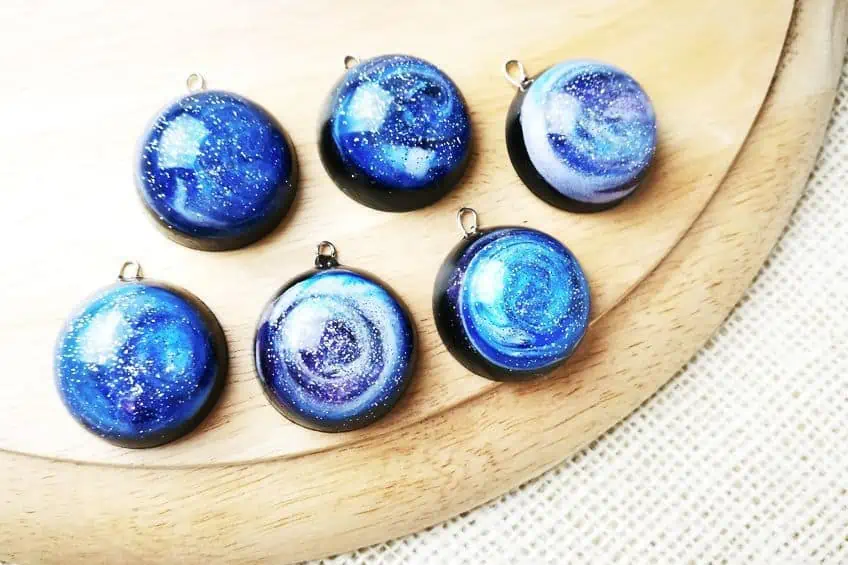
The resin that you would usually use to coat a surface is what’s known as tabletop epoxy resin or surface resin for short. This resin is thicker and sets a lot quicker than the type of resin that you would use to make castings, and because it’s thicker it tends to be very challenging to pour in large volumes. This is due to the change in consistency which makes it hard to manage and causes the surface resin to be nearly impossible to cure when used in this type of application.
Deep pour epoxy resin, on the other hand, has been specifically designed to be used and poured in large volumes, and to aid it in this application you might notice that deep pour resin is much thinner in consistency compared to surface pour resin.
This means you can use casting epoxy resin in large volumes with far less hassle than you would with the surface pour type. Deep pour resin does take longer to cure though, this ensures that the temperature during the hardening process is stabilized and ensures nothing cracks. this means that it’s not ideal to use for surface pour applications as it will start to run very quickly. This being said, the difference in both the cure times and consistency of deep pour and surface pour resin means that they’re best left to their intended applications, as while you might be able to pull off using them interchangeably, the quality of finish you’ll be left with would be very good. On the other hand, you can use these resins together on a single workpiece or over one another if one has had a chance to cure completely before you apply the other.
Applications for Deep Casting Resin and Surface Pour Resin
As we mentioned previously, because of their inherent differences deep casting resin and surface resin are only suitable for their intended applications. Knowing this, we have prepared a shortlist of the various applications that each of these resin types is intended for use with.
| Coating Resin | Deep Pour Resin |
| Coating countertops | Jewelry making |
| Preserving puzzles | Casting figurines |
| Preserving stone and masonry | Deep pour tabletops |
| Preserving book covers | Filling gaps in furniture |
| Coating exterior wood surfaces | Installation art |
A note on the hardness once cured: Casting resin is always less hard than coating resins. So for mechanical usage, it’s advised to put a coating resin on top, a food-safe one if you get in touch with food.
How to Use Deep Pour Resin Effectively
Now that you have some of the best deep pour epoxy resin products on the market to choose from, it’s probably a good idea if you know how to use your deep pour resin. Even if you have the best deep pour epoxy resin you should consider how you’ll prepare and apply your epoxy, that is why we’ve made a short tutorial detailing how to use your resin in the most effective way possible.
Here are a few things you’ll need to get started.
- Resin and hardener
- A few clean cloths
- A mixing stick
- Some soap and water
- Two measuring cups
- One large mixing cup
- A heat gun
Prepare Your Workspace
Before you get to pour your resin it’s probably a good idea to get your workplace prepared. Resin is a pretty messy substance to work with especially if this is your first-time casting. Get started by placing a tarp or some old newspaper over your workstation and floor of your work area. This should prevent any resin from accidentally spilling or splattering all over your furnishings while you work. Also, ensure that regardless of the type of resin you’re working with that your workspace is always well ventilated and that you are always wearing the appropriate personal protective gear. What personal protective gear should you be wearing? Preferably a face mask and a pair of gloves graded for use with epoxy.
Ensure that you have prepared all of these measures adequately before moving on to the next step in the process.
Prepare Your Workpiece
Preparing both your workspace and your workpiece are the most important steps when working with epoxy resin. Why? Well, if your workpiece isn’t prepared correctly this could result in contamination of your resin product or poor adhesion to the surface of your workpiece. This is the last thing you want because if your resin adheres poorly or is contaminated you might need to remove all of the resin you’ve poured, clean the surface of your workpiece and start the process all over again.

How do you prepare your workpiece, you ask? Well, you can start by cleaning it to the best of your ability, if you’re casting it into a wooden workpiece, you should clean it off with some soapy water and a rag and allow it to dry. If you’re pouring into a metal surface or glass, you can use an alcohol-based cleaning product and allow it to dissipate completely before you use your resin on them. Now that your workpiece is nice and clean you should do one last inspection to ensure that there are no chips or holes that would otherwise affect the aesthetic impact of your workpiece. If there are, use a wood or plastic filler to get these gaps filled up, or if you think that it could still work with the overall aesthetic that you’re going for, you can move on to the next step in the process.
Prepare Your Resin
This can be tricky to execute depending on what type of resin you’ve chosen to go with, but since we’re discussing deep pour resin we’ve going to go ahead and give you a quick rundown on how to mix your deep pour resin epoxy resin kit for pouring. Deep pour resin is different from surface pour resin in that both components need to be mixed in a ratio that is 2:1 instead of 1:1.

What does this mean? This means that you’re going to use twice as much resin as you do hardener.
For example, if you have a full cup of resin, you will be using half a cup of hardener to catalyze the substance. This change in ratios is also what makes deep pour resin cure much slower compared to surface resin, but it allows you to pour much more of the resin before the viscosity becomes more like gelatin which can be challenging to say the least. Once you’ve decided on how much resin you need, pour your resin and hardener into separate measuring containers.
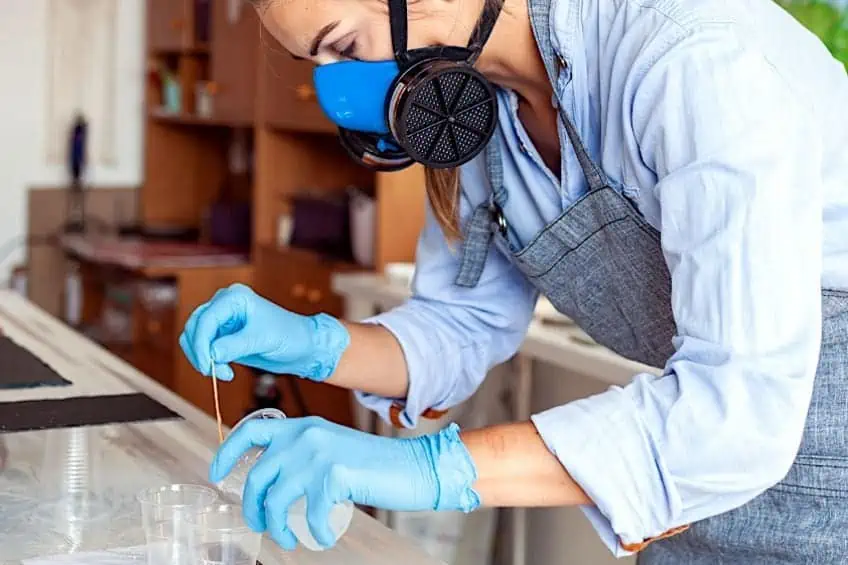
None of the products we mentioned previously are sold with these, so you might want to get some before you crack open your resin. Once you have some, pour both mixtures into one container and mix them together well. Some manufacturers will include additional instructions about how to prepare their particular brand, but this is generally how most preparation steps are executed. Before moving on to the next step in the process, always ensure that you have enough resin for the space you’re trying to fill.
Pour Your Resin
Now for the fun part! Okay before you go about dumping all of your resin into your workpiece you should ensure that you know how to go about it correctly. When deep pouring resin, it should always be done in layers, and if you’re wondering why, it’s because of the thermal reaction that causes the resin to harden and cure.
Resin generates a lot of heat during the chemical reaction and curing process, and if you pour too much of it in at once, you’ll wait really long for the resin to cure if it cures correctly at all.
We recommend pouring in layers of about an inch thick at a time if your workpiece is really big, and even if it isn’t this is a good metric to work with considering that it would take too long to pour or cure. When pouring, ensure that you do so slowly, allowing the resin to settle and level out inside your workpiece so that it rests in a nice even position by the time you’re done. Once your first layer is poured, allow it to cure for the manufacturer’s recommended time before pouring the next layer. Repeat this process until the space has been filled to your satisfaction. Make sure to always wear safety gear, as you are working with chemicals
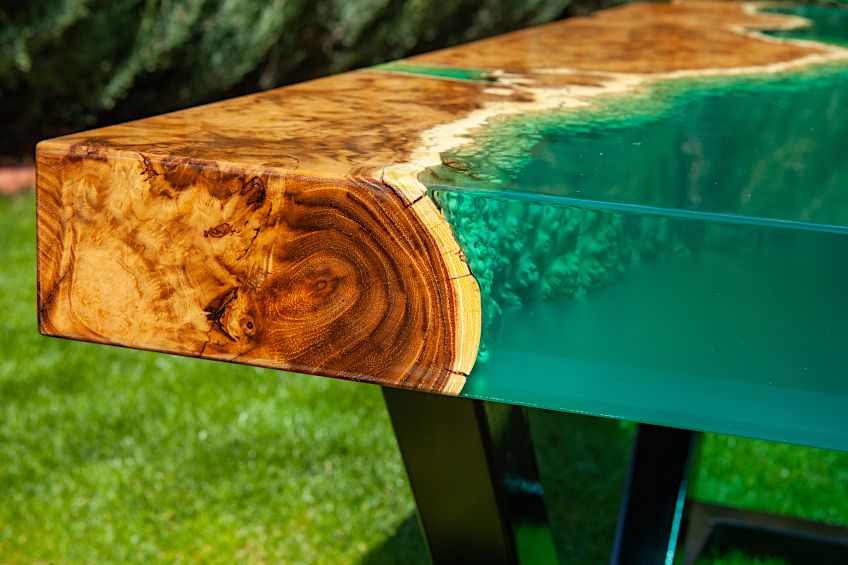
Now that you know why deep pour resin is used, what deep pour resin can be used for, what a good deep pour resin product looks like, and how to effectively use your deep pour resin, it’s time for you to go out and put your newfound knowledge to the test. Remember to always wear the appropriate personal protective gear and to always work in a well-ventilated area when working with any type of epoxy resin.
Frequently Asked Questions
What Is the Best Epoxy for Deep Pour?
Are you looking for the best epoxy for deep pour applications? Well, although there are loads of products out there that do this, it’s best to go with reputable brands that reduce the possibility of air bubbles, are resistant to things like UV, impact, abrasion, and are able to accept color agents like dyes, alcohol ink and pigments.
How Thick Can You Pour Epoxy Resin?
If you’re using deep pour resin, how thick can you pour epoxy resin before it becomes unmanageable? Well, while most deep pour resin products advise that you can pour them in two-inch-thick layers, we recommend aiming for just under an inch and a half to reduce curing time. Going over two inches would create quite a bit of heat which could result in your epoxy curing poorly.
How to Pour Resin with Deep Workpieces?
Wondering how to pour resin with really deep workpieces? You should consider pouring slowly and not rushing the process. Allow each layer to set at the very least before pouring the next. Also, ensure that you keep your workpiece as cool as possible throughout the pouring and curing process to avoid any abnormalities in your resin.
In 2005, Charlene completed her wellness degrees in therapeutic aromatherapy and reflexology at the International School of Reflexology and Meridian Therapy. She worked for a company offering corporate wellness programs for several years before opening her own therapy practice. In 2015, she was asked by a digital marketer friend to join her company as a content creator, and it was here that she discovered her enthusiasm for writing. Since entering the world of content creation, she has gained a lot of experience over the years writing about various topics such as beauty, health, wellness, travel, crafting, and much more. Due to various circumstances, she had to give up her therapy practice and now works as a freelance writer. Since she is a very creative person and as a balance to writing likes to be active in various areas of art and crafts, the activity at acrylgiessen.com is perfect for her to contribute their knowledge and experience in various creative topics.
Learn more about Charlene Lewis and about us.
